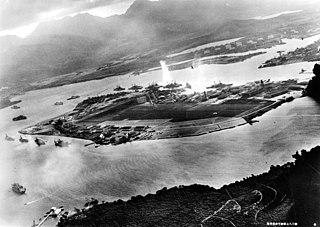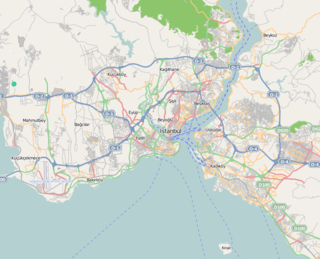
The Attack on Pearl Harbor was a surprise military strike by the Imperial Japanese Navy Air Service against the United States naval base at Pearl Harbor, Hawaii Territory, on the morning of December 7, 1941. The attack, also known as the Battle of Pearl Harbor, led to the United States' formal entry into World War II. The Japanese military leadership referred to the attack as the Hawaii Operation and Operation AI, and as Operation Z during its planning.

The Blitz was a German bombing campaign against Britain in 1940 and 1941, during the Second World War. The term was first used by the British press and is the German word for 'lightning'.

The Baedeker Blitz or Baedeker raids were a series of attacks by the Luftwaffe on English cities during the Second World War.

A strike is a directed physical attack with either a part of the human body or with an inanimate object intended to cause blunt trauma or penetrating trauma upon an opponent.
A surgical strike is a military attack which is intended to damage only a legitimate military target, with no or minimal collateral damage to surrounding structures, vehicles, buildings, or the general public infrastructure and utilities.

Operation Bodenplatte (Baseplate), launched on 1 January 1945, was an attempt by the Luftwaffe to cripple Allied air forces in the Low Countries during the Second World War. The goal of Bodenplatte was to gain air superiority during the stagnant stage of the Battle of the Bulge so that the German Army and Waffen-SS forces could resume their advance. The operation was planned for 16 December 1944, but was delayed repeatedly due to bad weather until New Year’s Day, the first day that happened to be suitable.
A tank is a style of character in gaming, often associated with a character class. A common convention in real-time strategy games, role-playing games, fighting games, multiplayer online battle arenas and MUDs, tanks redirect enemy attacks or attention toward themselves in order to protect other characters or units. Since this role often requires them to suffer large amounts of damage, they rely on large amounts of vitality or armor, healing by other party members, evasiveness and misdirection, or self regeneration.
The 2002 Soweto Bombings were a string of terrorist attacks that occurred in Soweto in South Africa's Gauteng province. Eight blasts took place on 30 October 2002, leaving one woman dead and her husband severely injured. One of the blasts severely damaged a mosque, while others targeted railways and petrol stations in the area. Police prevented one blast. Another bomb later detonated outside the Nan Hua Buddhist temple in Bronkhorstspruit, east of Pretoria. A white supremacist group, the Warriors of the Boer Nation, claimed responsibility for these explosions in a message sent to an Afrikaans newspaper.

Allied forces conducted many air raids on Japan during World War II, causing extensive destruction to the country's cities and killing between 241,000 and 900,000 people. During the first years of the Pacific War these attacks were limited to the Doolittle Raid in April 1942 and small-scale raids on military positions in the Kuril Islands from mid-1943. Strategic bombing raids began in June 1944 and continued until the end of the war in August 1945. Allied naval and land-based tactical air units also attacked Japan during 1945.

The Hull Blitz was the bombing campaign that targeted the English port city of Kingston upon Hull by the German Luftwaffe during the Second World War.

The Bombardment of Curaçao refers to a 1942 German naval bombardment of a Bullen Baai Company petroleum storage facility on the small South American island of Curaçao during World War II. The raid to destroy or ignite the petroleum failed and the German U-boat responsible was unsuccessfully engaged by a Dutch shore battery before escaping.
Suicide Bombing was a popular tactic of the Liberation Tigers of Tamil Eelam. According to Jane's Information Group, between 1980 and 2000, the LTTE carried out 168 suicide attacks causing heavy damage on civilian, economic and military targets.
In computers and computer networks an attack is any attempt to expose, alter, disable, destroy, steal or gain unauthorized access to or make unauthorized use of an asset. A cyberattack is any type of offensive maneuver that targets computer information systems, infrastructures, computer networks, or personal computer devices. Depending on context, cyberattacks can be part of cyberwarfare or cyberterrorism. A cyberattack can be employed by nation-states, individuals, groups, society or organizations. A cyberattack may originate from an anonymous source.

On 7 June 2016, at around 08:40 (UTC+3), a bombing occurred in central Istanbul, Turkey, killing 12 people and injuring 51 others, three of them seriously. The attack targeted a bus carrying policemen as the vehicle passed through the Vezneciler district near the Şehzade Mosque and the Vezneciler Metro station.

On 3 July 2016, ISIL militants carried out coordinated bomb attacks in Baghdad that killed nearly 400 civilians and injured hundreds more. A few minutes after midnight local time, a suicide truck-bomb targeted the mainly Shia district of Karrada, busy with late night shoppers for Ramadan. A second roadside bomb was detonated in the suburb of Sha'ab, killing at least five.
The Brook's Club bomb attack occurred on 22 October 1974 on St James's Street in London. The Provisional Irish Republican Army's Active Service Unit nicknamed the "Balcombe Street Gang" threw a 5 lb (2.27 kg) bomb into an empty dining room causing extensive damage and injuring three members of staff of the Brook's gentlemans club. The attacks occurred just two weeks after the ASU began its bombing campaign with the Guildford pub bombings which killed 5, 1 civilian and 4 soldiers and injured over 60 others.
The Norwich Blitz refers to the heavy bombing of Norwich and surrounding area by the German Luftwaffe during World War II. The bombings launched on numerous British cities were known as the Blitz.









